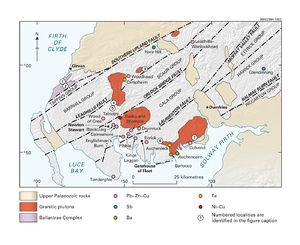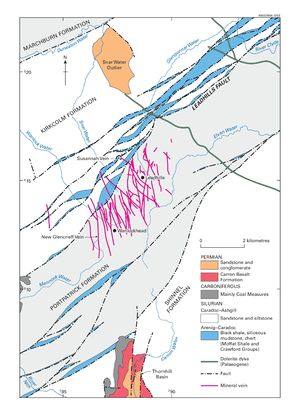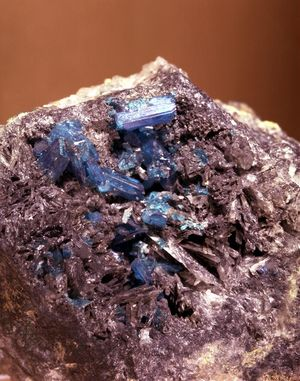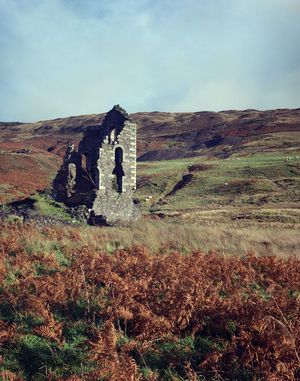Metalliferous and associated minerals resources, Southern Uplands
| Stone, P, McMillan, A A, Floyd, J D, Barnes, R P, and Phillips, E R. 2012. British regional geology: South of Scotland. Fourth edition. Keyworth, Nottingham: British Geological Survey. |
Introduction




Although there is currently no metalliferous mining in the south of Scotland, the lead-zinc veins of the Southern Uplands have provided an important resource that was extensively exploited from the 17th until the early 20th century, with records of mining at Leadhills going back as far as 1239 and the probability that there was some even earlier activity. Of greatest importance were the mines of the Leadhills–Wanlockhead district which, working just over 70 lead-zinc veins, was the largest metal mining operation in Scotland and produced about 400 000 tonnes of metallic lead, 10 000 tonnes of zinc and 25 tonnes of silver between 1700 and 1958. In addition, this same general area has produced gold from small-scale alluvial sources that were worked from the mid 16th century onwards. Farther to the southwest, in Galloway, the Woodhead mines near Carsphairn were an important source of lead in the mid 19th century, whilst base metal veins between Newton Stewart and Gatehouse of Fleet were mined from the late 18th to the early 20th centuries. From the Galloway mines, it is estimated that about 30 000 tonnes of lead were produced, together with smaller amounts of zinc and copper. Away from the principal mining districts are a range of mineralised locations, the more important of which, together with the Leadhills–Wanlockhead, Carsphairn and Galloway sites, are shown on P912376. Some of the more isolated sites have been worked on a small scale and others have been trialled, but most are too small to be of economic interest. Several different mineralisation styles are represented.
Lead-Zinc-Copper
Leadhills– Wanlockhead district
The 70 or so veins of the Leadhills–Wanlockhead mining field are spread over about 6 km of the regional strike of the host Lower Palaeozoic strata, which are mainly late Ordovician sandstones of the Portpatrick Formation. The majority of the veins run broadly north–south, though a few, which apparently formed later, have an approximately north-west to south-east trend (P912377). The north–south veins dip steeply to the east, the north-west trending veins dip steeply to the south-west. The vein orientations approximate to the late Caledonian fault pattern and it is likely that fault reactivation played a role in the localisation of the mineral deposits, most probably during Carboniferous times. Most of the veins terminate in the north against the Leadhills Fault, which is here a reverse structure dipping to the north-west at about 45°. In the hanging wall of the fault, an imbricate zone of crushed chert and mudstone (Crawford and Moffat Shale groups) may have acted as an impervious barrier to the mineralising fluids, whilst providing a fissile transfer plane for the extensional stress. Only a few veins cross the imbricate zone and continue into the overlying, quartzofeldspathic sandstones of the Kirkcolm Formation (P912377).
Mineralised fault sections are traceable for up to 3 km, whereas the largest of the workable ore bodies, in the New Glencrieff Vein, extended 360 m along strike and 400 m down dip. More commonly, the strike length of individual ore bodies was about 50 m, extending about 100 m down-dip. Elsewhere, the veins are typically banded fissure fillings, several centimetres to about 5 m in width, consisting of brecciated Ordovician sandstone cemented by quartz, dolomite, calcite and locally baryte, and cut by sulphide stringers containing galena, sphalerite, chalcopyrite and pyrite. The carbonates were the earliest-formed gangue minerals, and their subsequent replacement by quartz was associated with the introduction of a second generation of sulphides. There is some evidence for mineral zonation, with sphalerite increasing with depth relative to galena. Around the mineralised zones, hydrothermal alteration forms a diffuse halo in the Ordovician sandstone country rock.
A great variety of minerals have been identified in the Leadhills–Wanlockhead veins; almost 60 at last count and still rising. A few rare, primary ore minerals accompany the dominant galena-sphalerite association, but most of the unusual minerals reported are secondary. Most were found in an oxidised zone that in places reached a depth of 180 m, suggesting that in the past the water table was much lower than it is at present. Some of the secondary forms present are relatively common, for example the hydrated copper mineral malachite, but rare secondary minerals that have their type locality within the district, and so are named accordingly, include leadhillite, lanarkite, caledonite (P243193), and susannite, the latter named from the Susannah Vein. These, and most of the other secondary minerals present, are complex, variably oxidised and hydrated, mixed sulphate-carbonates of lead, zinc and/or copper.
Spoil tips and the remains of headgear and mine buildings still bear testament to the extensive mining activities in the Leadhills–Wanlockhill district and at Leadhills some have now been preserved and incorporated into the Scottish Lead Mining Museum.
Galloway district
The most important of the Galloway mineral veins lie in a 7–8 km wide zone extending from the north of Newton Stewart, south-east towards Gatehouse of Fleet (P912376). The zone skirts the south-west margin of the Cairnsmore of Fleet pluton, though the mineral veins are hosted by Ordovician, Shinnel Formation sandstones in the north, and Silurian, Gala Group sandstone in the south, all within the pluton’s thermal aureole. The veins are of epigenetic origin, with stringers of mostly galena and sphalerite but locally with chalcopyrite dominating, in a dolomite-calcite-baryte-quartz gangue occupying brecciated zones, up to 18 m wide at Blackcraig (NX 445 647), but usually much narrower. Most of the veins trend broadly north-west, though there is considerable local variation ranging from almost north–south at Wood of Cree (NX 386 695), where in addition to the underground mining there was some opencast working of a brecciated zone 4.5m wide, to east-north-east at Rusco (NX 553 615), where the mineralised zone was only 0.3 m wide.
The most important of the Galloway mines were those in the Blackcraig–Cairnsmore complex (P912376). These mines most probably all worked the same north-west-trending vein over a strike length of almost 4 km, though individual economic ore runs did not exceed 500 m; to the north-west the vein passes into unmineralised quartz. The Blackcraig–Cairnsmore mines were operated intermittently between 1743 and 1882 with some very limited activity in the early 1920s. The most productive phase was between 1853 and 1881 when the Blackcraig mines are reported to have produced 3820 tons of lead, 1668 tons of zincblende (sphalerite) and 28 tons of copper. The Cairnsmore mine had a relatively brief life of only about 15 to 20 years in the mid 19th Century, but in that time a little over 3000 tons of lead ore were produced. Two closely spaced, parallel veins were worked at Cairnsmore, cutting across both sandstone and mudstone, but were apparently only economic where they cut the mudstone. A similar situation was reported farther south-east at the Pibble Mine (NX 527 605) where the most productive sector of the north-north-west-trending vein cuts across mudstone of the Moffat Shale Group, wherein there is some evidence for disseminated mineralisation. Although principally a lead-zinc mine, Pibble was the largest producer of copper in Galloway, albeit this amounted to only a few hundred tons of metal; the remains of the engine house still stand (P001527) amidst traces of adits, surface workings and spoil heaps.
Copper, mostly as chalcopyrite, was the main product of several of the smaller and short- lived Galloway mines. For example, at Enrick (NX 619 550) about 2.5 km south-east of Gatehouse of Fleet, a breccia vein in Kirkmaiden Formation sandstone, trending east–west and 1–2 m wide, contained chalcopyrite in a calcite-quartz-dolomite gangue; it was worked at several levels for a few years after its discovery in 1820. Farther east, in a coastal location on the south side of the Criffel pluton, the Colvend Mine (NX 868 528) was active around 1770. It worked a breccia vein about 1 m wide that cut Ross Formation sandstone and intrusive microdiorite sheets; chalcopyrite, malachite and azurite are reported to have been present in a quartz-calcite gangue.
The age and metallogenesis of the Galloway veins is uncertain. The proximity of the major ity of veins to the Cairsmore of Fleet granite pluton invites an association with its ‘Acadian’ intrusion at about 400 Ma and a concentric, compositional zoning of the mineralisation, subparallel to the pluton margin, has been proposed. However, as at Leadhills–Wanlock head, the orientation of the veins broadly follows the Caledonian, north-west and north-north east-trending cross faults, and a similar history of mineralisation during Carboniferous fault reactivation could be argued. The Blackcraig vein is apparently closely associated for much of its length with an olivine dolerite dyke, but the relationship between the dyke and the mineralisation is uncertain, as is the age of the dyke, perhaps Permo-Carboniferous, perhaps Palaeogene. The ultimate source of the metals is similarly uncertain, but may be hinted at by the disseminated mineralisation in Moffat Shale Group mudstone described from the Pibble Mine. Disseminated mineralisation has also been reported from Moffat Shale Group strata elsewhere in the region, for example at Penkiln Burn (NX 446 767), 10 km north-north-east from Newton Stewart (P912376).
Carsphairn district
About 3 km to the west of Carsphairn village are the remains of the Woodhead lead mine (NX 530 938), which include several shafts in close proximity, spoil heaps and various surface facilities. There are two main veins trending approximately north-west, following a brecciated fault zone in the host sandstone of the Ordovician Kirkcolm Formation. Galena is the principal ore mineral, accompanied by sphalerite and some chalcopyrite, set in a gangue of calcite, dolomite and quartz. Mining (initially opencast) was active from 1838 until late in the 19th century and in the most productive period, 1840 to 1852, annual lead production peaked at 905 tons.
Baryte
Baryte occurs widely as a gangue mineral in the lead-zinc veins of Leadhills–Wanlockhead and Galloway but in these mining areas appears only to have been commercially produced, on a small scale, at the Cairnsmore mine in Galloway. Of greater importance were baryte veins to the east-south-east of Kirkcudbright at Barlocco (NX 785 474) and Auchencairn (NX 816 483) (P912376). At Barlocco, two veins trend approximately east–west, are up to 2.4 m wide, and cut Silurian sandstone of the Ross Formation (Hawick Group). About 3000 tonnes of baryte were reported to have been extracted between 1856 and 1920 with some intermittent and small-scale activity continuing until the early 1950s. At Auchencairn, the baryte vein trends east-north-east, is about 0.6 m wide and cuts Carboniferous sandstone of the Rascarrel Member, Fell Sandstone Formation. The Auchencairn mine had a relatively short life, producing about 700 tonnes of baryte in the 1860s.
Gold-arsenic-antimony
At the western margin of the Criffel–Dalbeattie granodioritic pluton, in the Black Stockarton Moor area (NX 725 555), Silurian sandstones of the Hawick Group have been intruded by a complex of intersecting volcanogenic breccia pipes, felsic dykes and small granodioritic bodies (see Chapter 4). The whole complex is associated with weak copper-molybdenum mineralisation of porphyry-copper type with a wide zone of hydrothermal alteration centred on an inner zone with chalcopyrite-bornite veining. This mineralisation is concentrated into brecciated zones which are also enriched in arsenic (arsenopyrite), antimony (stibnite) and gold, though gold assays show only up to 0.06 parts per million (ppm).
Adjacent to the eastern margin of the Carsphairn granitic intrusion, at Moorbrock Hill (NX 620 980), gold values of 1–3 ppm have been reported from quartz veins carrying pyrite, chalcopyrite and arsenopyrite in a north-east-trending zone of intense brecciation and hydrothermal alteration of the host Ordovician (Kirkcolm Formation) sandstone and mudstone. The gold forms small, isolated grains, usually in association with pyrite-chalcopyrite inter-growths. To the south, at the southern margin of the Loch Doon pluton in the Glenhead Burn area (NX 449 780), arsenopyrite, pyrite and native gold occur in thin quartz veins cutting brecciated and hydrothermally altered Ordovician sandstone of the Portpatrick Formation. In the most intensely mineralised material, arsenic levels range up to 3.5 per cent and gold reaches 8.8 ppm. Lead-zinc veins are also present in both the Moorbrock Hill and Glenhead Burn localities and it seems likely that mineralisation was protracted as hydrothermal systems developed at the pluton margins and scavenged metals from the country rock. A similar origin seems likely for the antimony-lead veins at Hare Hill (NS 658 104), which cut a small, hydrothermally altered granodioritic intrusion adjacent to the Southern Upland Fault near New Cumnock. The veins are associated with a zoned development of arsenic-antimony-copperlead-zinc mineralisation. The Moorbrock Hill and Glenhead Burn mineralisations are relatively recent discoveries with no history of previous working. Trial workings have been driven into the Hare Hill veins, but there is no record of their having been economically mined.
In the south-central part of the Southern Uplands antimony was won from the Louisa Mine (NY 313 966) at Glendinning, about 6 km east of Eskdalemuir. About 200 tonnes of antimony were produced in the late 19th century from a north-east-trending network of thin veins worked by shafts and adits. The antimony is principally contained in stibnite, but other antimony-bearing minerals are present, including semseyite, bournonite and tetrahedrite. Also commonly present are arsenopyrite, pyrite, chalcopyrite, galena and sphalerite, all contained in a quartz-carbonate gangue. The host rocks are Silurian sandstone of the Hawick Group, which modern exploration has shown to contain stratabound disseminations of pyrite and arsenopyrite concentrated into debris flow beds of intraformational conglomerate up to 4 m thick and containing 0.75 per cent arsenic. The arsenopyrite contains up to 0.4 per cent gold and 0.33 per cent antimony, whilst the pyrite contains up to 5 per cent arsenic. These relationships suggest a complex mineralisation history, and a possible source for the vein mineralisation.
Alluvial gold
Gold had been discovered in the stream gravels of the Leadhills–Wanlockhead district by the beginning of the 16th century. One record from 1502 describes a nugget almost 1 kg in weight, and by about 1510 gold extraction was being carried out on an organised basis. Extant documents show that 113 ounces of Leadhills gold were used to augment the Scottish crown jewels between 1537 and 1541, and that over a period of 30 days in 1579, 128 ounces of gold were sent to the Scottish Mint. Thereafter, production declined as the richest deposits were worked-out, but intermittent sluicing operations continued until the mid 20th century, and gold is still panned from the streams by hobbyists.
The two villages of Leadhills and Wanlockhead occupy high ground with radial drainage: the Mennock Water to the south-west, the Wanlock Water, Snar Water and Glengonnar Water to the north, and the Elvan Water to the east (P912377). Gold has been recovered from all of these streams and from many of their tributaries, with the early workers reported to favour gravel beds preserved locally between rockhead and the overlying glacial till and exposed in the stream banks. These sources are estimated to have given a yield of between 5 and 10 grams per tonne. Though clearly local, a bedrock source for the alluvial gold has not been established. To compound this difficulty, modern microchemical analyses suggest that the gold might have been derived from at least four different geological environments. The dominant type present is probably of mesothermal shear zone origin and has microscopic arsenopyrite inclusions. Also present are grains thought to have been derived from: gold concentrated along the margins of mafic, Palaeogene dykes; gold associated with ultramafic rock (most probably recycled from the glacial till); and gold concentrated by the downward movement of the oxidising groundwater solutions circulating within the nearby Permian red-bed basins. Some gold grains have characteristics that do not fit readily into any of these categories.
Chromium and nickel
Chrome spinel is a widespread accessory mineral in the serpentinised ultramafic rock of the Lower Ordovician Ballantrae Complex, but is particularly concentrated at two localities, in both cases hosted by serpentinised dunite. Neither of these localities has been deemed of commercial interest in their own right, but their presence has stimulated extensive, though unsuccessful, mineral exploration elsewhere in the Ballantrae Complex. In the northern serpentinite belt, at Pinbain Bridge (NX 138 916), spinel (a true chromite in this case) forms between 30 per cent and 90 per cent of a lensoid body 4–5 m wide and several tens of metres long. In the southern serpentinite belt, at Poundland Burn (NX 170 882), nodular iron-rich chrome spinel (picotite) forms up to 70 per cent of a restricted area of outcrop. Sparse Ni-Cu mineralisation is also widely associated with the ultramafic rock. Within the Southern Uplands massif, an unusual occurrence of Ni-Cu sulphide minerals forms a small basal lens (c. 1 x 4 x 20 m) in a dioritic, sill-like body intruded into Silurian, Gala Group sandstone at Talnotry (NX 4785 7035). The principal ore minerals are pyrrhotite, pentlandite, chalcopyrite, nickeline and gersdorffite. The deposit was worked soon after its discovery in about 1885, but though about 100 tons of ore were raised, very little was removed from the site.
Uranium
Pitchblende (uranium oxide) is present in thin polymetallic-carbonate breccia veins adjacent to the North Solway Fault and close to the southern margin of the Criffel–Dalbeattie pluton at Needle’s Eye (NX 915 562). The veins cut thermally metamorphosed, Silurian Riccarton Group sandstone and Carboniferous strata of the Border Group. Associated with the pitchblende are abundant secondary uranium minerals. The pitchblende has been dated at 185 ± 20 Ma, an age which has been taken to show Mesozoic movement on the North Solway Fault (see Chapter 7), but the date has been questioned and a late Caledonian age suggested for the veins based on their close proximity to the granite pluton (c. 397 Ma). The Needle’s Eye site has been much studied as a natural analogue for the radionuclide migration that may occur around sites housing radioactive waste.
Haematite
About 3 km to the west of the Woodhead lead mine a substantial haematite breccia vein, up to 3 m wide, transects the margin of the Loch Doon Pluton and its metamorphic aureole in Kirkcolm Formation sandstone. The vein runs north–south for a distance of about 3 km (NX 505 911 to NX 503 938). It was worked intermittently between 1869 and 1876, but though about 400 tons of ore were raised it proved to be of poor quality and the enterprise was abandoned. Several haematite breccia veins are also known from the western margin of the Criffel–Dalbeattie Pluton, where they cut both the igneous rock and its sedimentary host, sandstone of the Hawick Group. In the largest of these veins, which cuts the granite at Auchenleck (NX 773 525), botryoidal haematite is accompanied by quartz and baryte. The Auchenleck vein trends west-north-west and was reputedly up to 20 m wide. It was extensively worked in the early to mid 19th century, with a report from 1845 that 50–70 tons of ore per week were then being extracted.
The haematite veins may have a similar origin to the much more extensive deposits farther south in west Cumbria, and to the associated veins at Maughold Head in the north-east of the Isle of Man. These deposits are thought to be late Permian or Early Triassic in age and to have been formed from mineralising fluids circulating in the Permo-Triassic sedimentary rocks of the Irish Sea Basin. It is possible that a former covering of permeable Permo-Triassic or Carboniferous rocks acted as a pathway that enabled mineralising fluids to gain access to fractures within the Lower Palaeozoic sandstone and Caledonian granites of south-west Scotland.
Bibliography
Gillanders, R J. 1981. The Leadhills–Wanlockhead mining district, Scotland. The Mineralogical Record, Vol. 12, 235–250.
Hyslop, E, McMillan, A, and Maxwell, I. 2006. Stone in Scotland. Earth Science Series: (Paris: UNESCO, IAEG, Queen’s Printer for Scotland and British Geological Survey.)
Leake, R C, Chapman, R J, Bland, D J, Stone, P, Cameron, D G, and Styles, M T. 1998. The origin of alluvial gold in the Leadhills area of Scotland: evidence from interpretation of internal chemical characteristics. Journal of Geochemical Exploration, Vol. 63, 7–36.
MacDonald, A M, Ó Dochartaigh, B É, Kinniburgh, D G, and Darling, W G. 2008. Baseline Scotland: groundwater chemistry of southern Scotland. British Geological Survey Open Report, OR/08/62.
Musson, R M W. 2004. Early seismicity of the Scottish Borders Region. Annals of Geophysics, Vol. 47, 1827–1847.
Musson, R M W. 2007. British Earthquakes. Proceedings of the Geologists’ Association, Vol. 118, 305–337.
Musson, R M W, and Henni, P H O. 2002. The felt effects of the Carlisle earthquake of 26 December 1979. Scottish Journal of Geology, Vol. 38, 113–125. Robbins, N S, and Buckley, D K. 1988. Characteristics of the Permian and Triassic aquifers of south-west Scotland. Quarterly Journal of Engineering Geology, Vol. 21, 329–335.
Scheib, C, Appleton, J D, Miles, J C H, Green, B M R, Barlow, T S, and Jones, D G. 2009. Geological control on radon potential in Scotland. Scottish Journal of Geology, Vol. 45, 147–160.
Stone, P, Cook, J M, McDermott, C, Robinson, J J, and Simpson, P R. 1995. Lithostratigraphical and structural controls on distribution of As and Au in south-west Southern Uplands, Scotland. Transactions of the Institution of Mining and Metallurgy, Section B, Vol. 106, 79–84.
Stone, P, Breward, N, and Merriman, R J. 2003. Mineralogical controls on metal distribution in stream sediment derived from the Caledonides of the Scottish Southern Uplands and English Lake District. Mineralogical Magazine, Vol. 67, 325–338.
Temple, A K. 1956. The Leadhills–Wanlockhead lead and zinc deposits. Transactions of the Royal Society of Edinburgh: Earth Sciences, Vol. 63, 85–113.